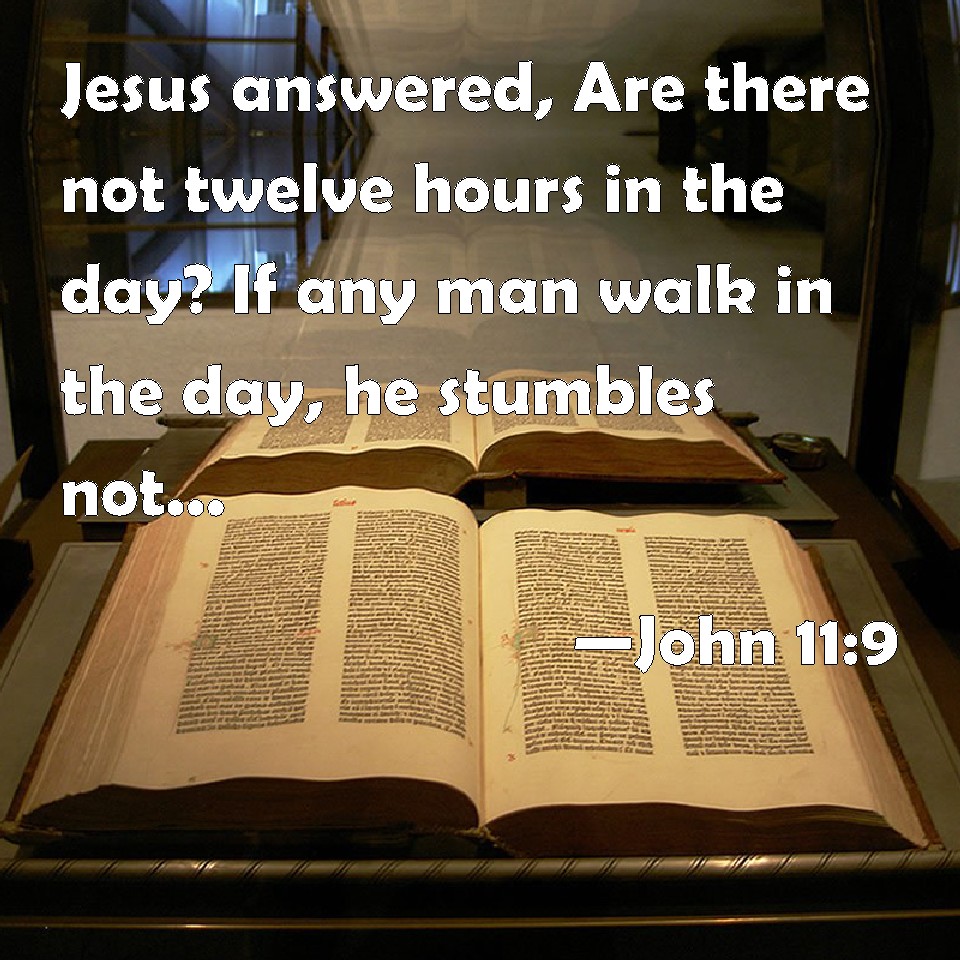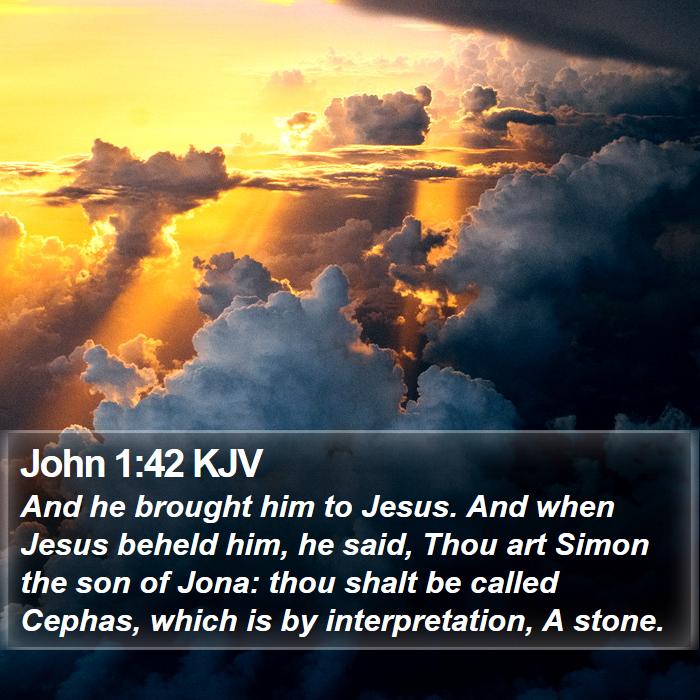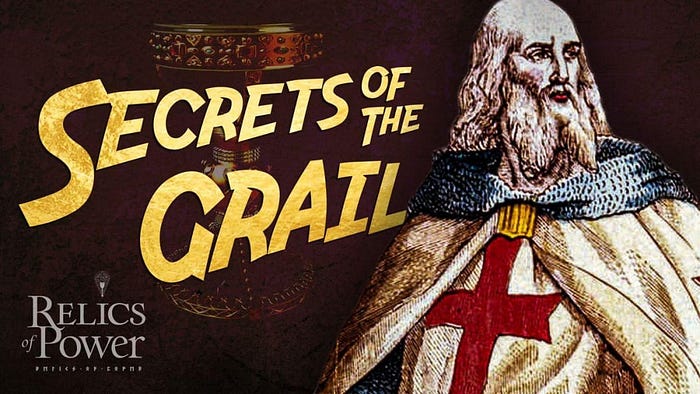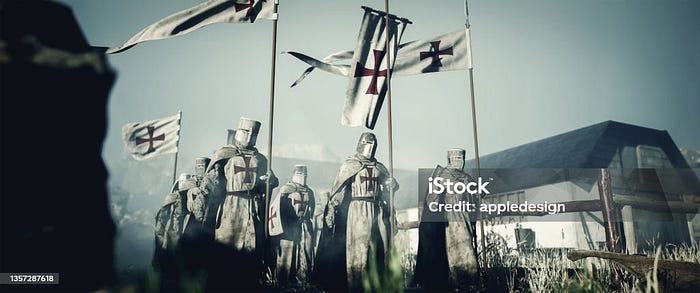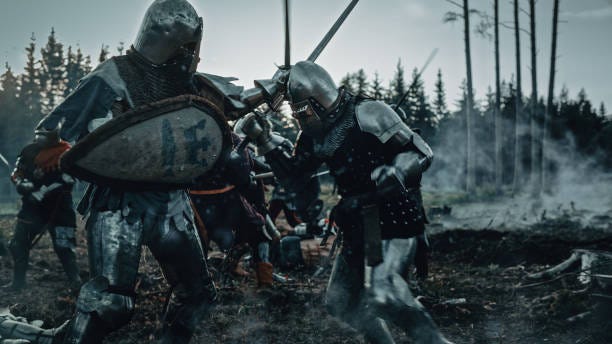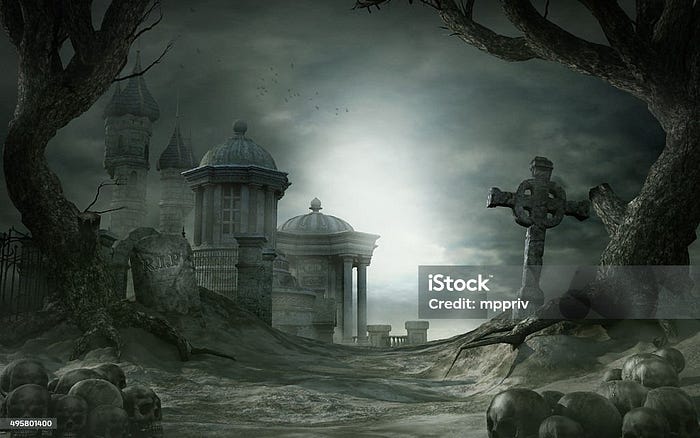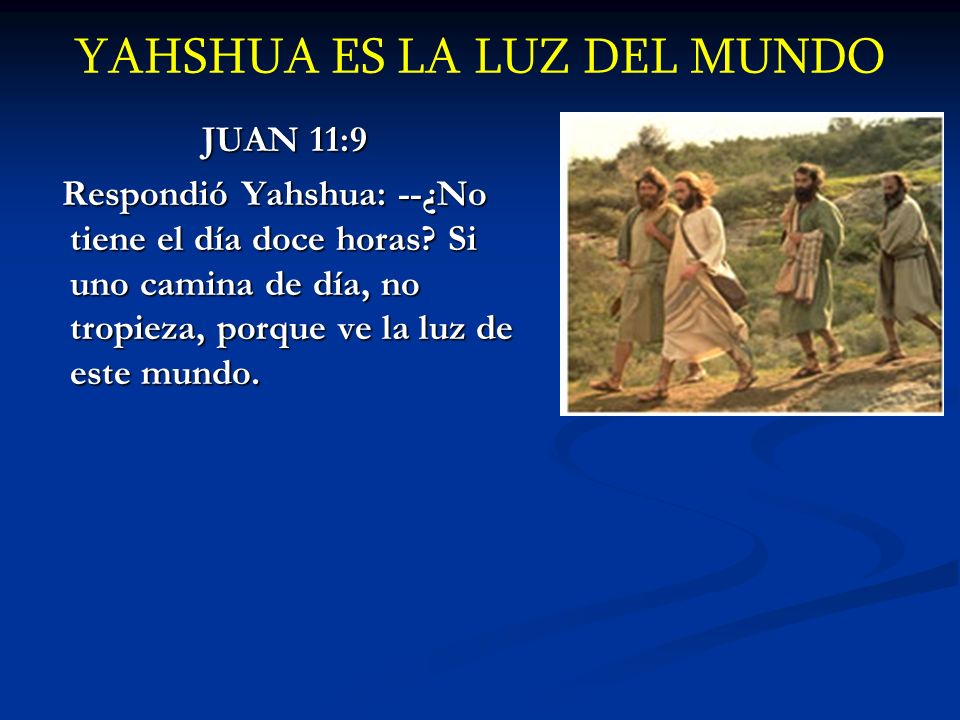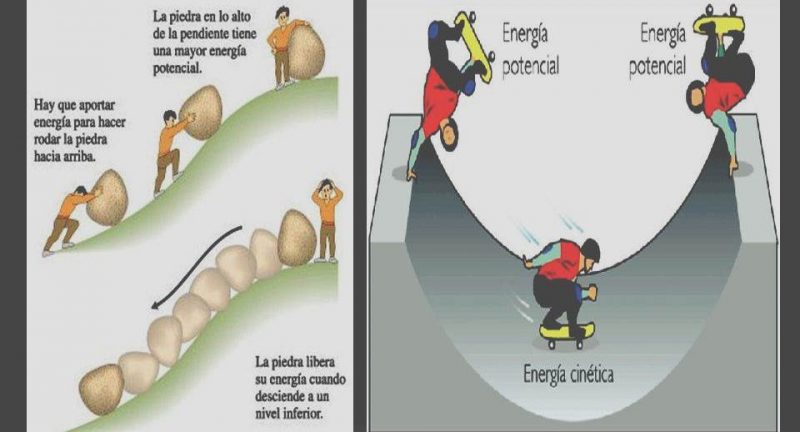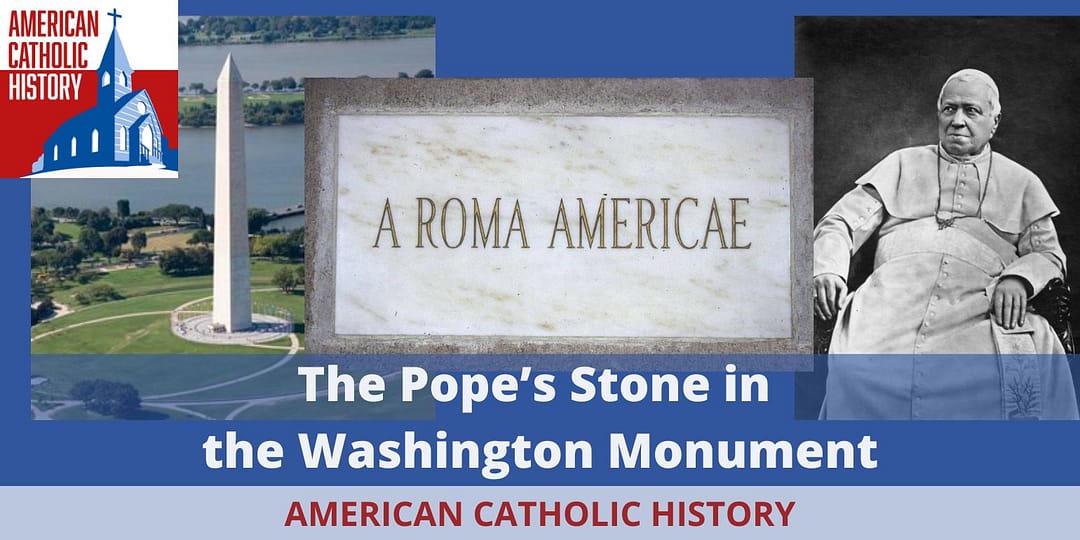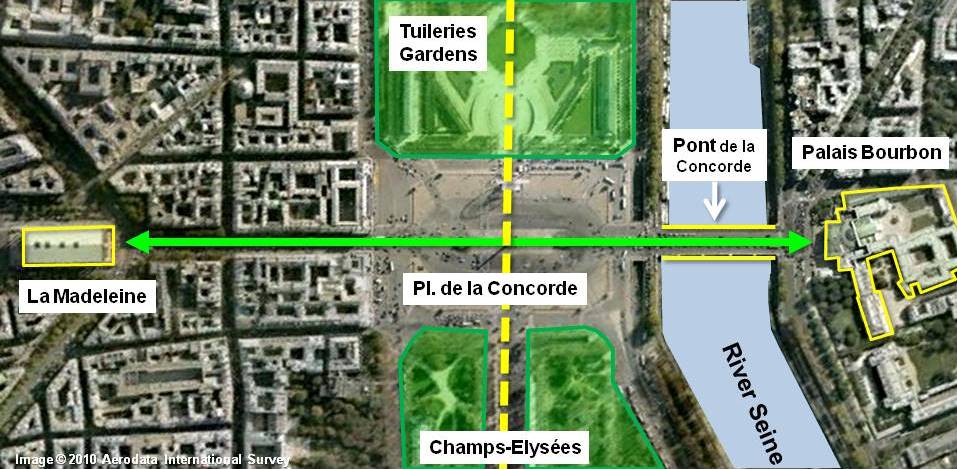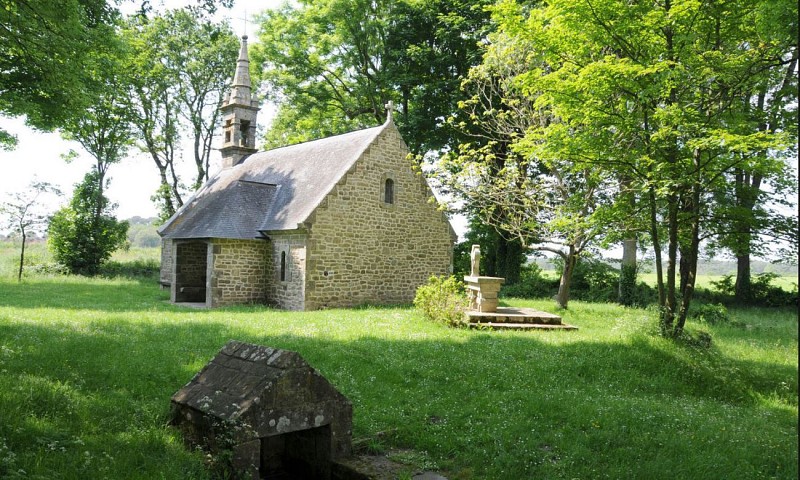|
|
The Holy Grail Story
Backstory — The Holy Grail:-
The Holy Grail Story is told in ancient legends such as King Arthur and the Round Table. Meanwhile, Hollywood blockbuster movies like “Indiana Jones and the Last Crusade” and (Dan Brown’s) “The Da Vinci Code” are today’s topics to discuss. These stories are defined in different aspects. They believe in a relic with supernatural powers that dates back to Christ. Furthermore, others believe the Grail is a miraculous “stone” or the sacred bloodline that carries Jesus’ blood.
But how many realities and secrets are hidden in these myths? We combine history and folk tales with science to investigate places and some of the literature. We also justify forgotten information to highlight this fantastic subject. Now it’s time to explore lost books and define major and incredible connections in our content.
BLOODY FATE of the Knights Templar Revealed | Buried: Knights Templar and Holy Grail
Here is a small reference to the previous article:-
Our last post highlighted “Rise TV Friday Night Live Show.” Rise TV is a unique streaming network that offers entertaining and inspiring shows, providing a refreshing escape from the negativity and confusion of the daily news cycle.
The Chalice Grail, the Church, and the Legend of Merlin and King Arthur:-
In infamous texts and journals, the Holy Grail is seen as a powerful item capable of granting unchanging life. These journals also describe abundance, healing, desires, and unlimited youth to its bearer.
According to traditional Christian belief, the chalice was held during the Last Supper as Jesus Christ used it as the holy Grail. Later, his blood was collected on the same chalice during his crucifixion. Some churches worldwide still claim to be the piece’s guardians and this chain of events gave the item its supernatural “powers.”
Centuries later, Robert de Boron and Parsifal by Chretien de Troyes and Wolfram von Eschenbach revived the Holy Grail tale in works like Merlin. These people identified themselves as poets and minstrels. But they were told the holy grail story that continues today and the story is full of difficulties and secrets. Their exceptional works slowly uncover these special tales brick by brick.
These poets described famous mythological Knight Templars such as King Arthur and his Round Table allies. A beginning and a spiritual trip continually described The Holy Grail hunt, the same as defined in legends. According to these legendary tales, the Knights Templars must show their purity of heart, and worth to face many trials and difficulties on their path.
The Living Grail, or Christ’s Bloodline:-
History explains that the sacred bloodline of “Jesus Christ” has been a controversial theory. However, it has recently achieved across-the-board attention because of Dan Brown’s writings. For centuries several authors have researched connecting this myth to find possible evidence. They searched for the secrets of the holy grail in monasteries, and libraries, and wrote chronicles for proof.
Also read this story on vocal media: the holy grail story & fall of knights Templar
Some authors and academics believe in this theory. After settling in Europe, José de Arimathea established a hidden bloodline “The Protectors of the Sangreal”. The family through this bloodline is considered a direct descendant of holy Jesus Christ and Mary Magdalene. According to this theory, the power and monarchy of Christ’s blood are also assumed as The Living Grail or its carrier.
The Catholic Church regards Christ’s ancestry as a hidden secret. They attempted to hide the reality that Jesus Christ had a wife, “Mary Magdalene” and their child still exists today. Perhaps, a group of people who had saved the family from potential harm and assassination. Because it was necessary to protect the holy family. On the other side of the story, the Church was also required to retain power through the Roman Empire.
Mythology mentions that the Merovingian dynasty was another element. So, they controlled France from the fifth to the eighth centuries. Historians assumed that the Merovingians were descended from Jesus Christ and his wife Mary Magdalene. This secret bloodline is known as “Sangreal”. The history mentioned Merovingian kings as “The Holy Kings”. Perhaps they were gifted with heavenly authority because they proudly carried Jesus Christ’s holy blood in their veins.
The “STONE” or Alchemical Grail (Philosopher’s Stone):-
One of our research’s most fascinating authors Wolfram von Eschenbach provided fresh proof of the Grail Legend. This proof defined “the Grail as a stone”, “not a chalice” or “a bloodline”.
Wolfram von Eschenbach’s mythology explains a historical belief. This mythology proves that the Grail Stone was made of a substance known as “Lapis exilis” or “Exile Stone.” It presumably fell from the sky in the form of a meteor. According to this German composer, this stone was the Grail’s source of power and vitality. Only the holy people with a pure heart and noble intentions may approach it and use its abilities.
The legend of the Chintamani Stone of Asia is shockingly similar to this narrative. The legend of the Emerald of Lucifer is also comparable to the previous theory which we will explore in future articles. It is said that The Stone had therapeutic abilities like other stories. The holy stone had to cure wounds and diseases, grant desires, and deliver visions for spiritual acknowledgements.
The Establishment and Early History of the Knights Templar:-
The Knights Templar were formed about 1119 and received papal approval in 1129. It was a Catholic military order in which participants combined martial prowess with a monastic lifestyle to protect Christian sacred sites and pilgrims in the Middle East and beyond. The Templars, headquartered in Jerusalem and later Acre, were a significant and elite component of Crusader armies.
The Knights Templar eventually grew to be a powerful organization, controlling castles and territory throughout the Levant and Europe. Accused of heresy, corruption, and forbidden acts, the order was assailed by French king Philip IV (r. 1285–1314) on Friday, October 13, 1307, and officially dissolved by Pope Clement V (r. 1305–1314) in 1312.
Foundation and Early History:-
The order was founded around 1119 when seven knights, led by Hugh of Payns, a French knight and nobleman from Champagne, vowed to protect Christian pilgrims in Jerusalem and the Holy Land, forming a brotherhood that took monastic vows, including vows of poverty and lived in an enclosed community with a set of rules of conduct.
In 1120, Baldwin II, the ruler of the Kingdom of Jerusalem (r. 1118–1131), offered the knights his palace, the old Aqsa Mosque on Jerusalem’s Temple Mount, to serve as headquarters. Because the structure was generally referred to as ‘The Temple of Solomon’, the brotherhood swiftly became known as ‘the Order of the Knights of the Temple of Solomon’ or simply the ‘Knights Templar’.
The Templars were formerly considered a branch of the Cistercians until Pope Honorius II (r. 1124–1130) officially recognized them as an order at the Council of Troyes in January 1129 (the first such military organization to be established). In 1145, knights of the order received authorization to wear the white hooded mantle that Cistercian monks had created.
The knights quickly adopted their unique white cloak and began to utilize the symbol of a red cross on a white background. Fighting was not prohibited by Catholic dogma as long as the purpose was just — the Wars of the Crusades and defense of the Holy Land being prime examples — and hence the organization got official Church endorsement. Templar knights fought their first significant combat against Muslims in 1147, during the Second Crusade (1147–1149).
Since the mid-12th era, the Templars have expanded their power by fighting in crusade battles in Iberia (the ‘Retake’) for different rulers in Spain and Portugal. By the 13th century, the Knights Templar held lands from England to Bohemia and had evolved into a truly multinational military organization with enormous resources (personnel, weaponry, equipment, and a sizable maritime fleet).
The Templars had devised a paradigm that would be followed by other military organizations such as the Teutonic Knights and Knights Hospitaller. However, there was one area where the Templars excelled: banking.
Uniform and Rules of the Knights Templar:-
Knights swore vows upon entering the order, similar to those taken in monasteries, but less rigorous and without the requirement to always remain in their communal quarters. The most essential commitment was obedience to the Grand Master; attendance at church services was required, as was celibacy, and community meals were provided (which occasionally included meat).
Worldly pleasures were not permitted, including such classically knightly pursuits as hunting and hawking, as well as not wearing the showy apparel and armaments that conventional knights were known for. Belts, for example, were frequently used as a means of ornamentation, but the Templars wore a simple wool cord belt to represent virginity.
Knights Templar wore a white coat and cloak over their armor, as previously stated, and a crimson cross on their left breast. The red cross appears in the horse livery and the order’s banner. This set them apart from the Knights Hospitaller (who wore a white cross on a black backdrop) and the Teutonic Knights (who wore a black cross on a white background).
Templar protection, in contrast, was often white with a broad black horizontal line over the top. Sergeants donned a brown or black cape or cloak. Another distinguishing aspect of the Templars was that they uniformly grew beards and had short hair.
Criticism, Trial, and Abolition:-
Western monarchs became leery of military instructions as they began to collect a vast network of holdings and cash reserves. The Templars, like other military orders, had long been accused of misusing their privileges and exploiting their financial affairs to maximize profit. They were charged with corruption, as well as excessive pride and greed. Critics claimed they led a leisurely life and wasted money that could have been spent preparing troops for the Holy War.
They were accused of squandering resources to compete with competing orders, particularly the Hospitallers. There was also the ancient belief that monks and warriors were an incompatible mix. Some even lambasted the directive for focusing solely on removing Muslims rather than converting them. The majority of these critiques were based on a lack of knowledge about the order’s operations, a distortion of their true wealth, and a general sense of jealousy and suspicion.
By the end of the 13th century, many people believed that the military orders were too independent for everyone’s benefit and that combining them into a single body would be the best way to make them more responsive to the Church and individual state rulers.
Then, beginning around 1307, much more serious accusations were leveled against the Templars. They were accused of denying Christ’s divinity, as well as the crucifixion and cross. There were rumors that initiation into the brotherhood entailed trampling, spitting, and peeing on a crucifix. These charges were made public, especially by the French government.
Ordinary clergy were also jealous of the order’s rights, such as burial, which might be a valuable sideline for any local church. The governmental and religious establishments.
What does the Knights Templar have to do with it…?
During the 12th century the Crusades era this order had been created. An armed and religious order of the Knights Templars officially came into existence. They defended the Christian people who came to Jerusalem. One of the most powerful and prominent Middle Ages orders had settled by this time. So, they accumulated money and property throughout Europe.
The Grail stories mentioned above (von Eschenbach, de Boron, and de Troyes) originated in the same period. Fresh evidence mentioned in studies is gaining attention. So, the association of the Templars with the Holy Grail is a repeating topic in several stories. In this scenario, everyone agreed with the story almost unanimously that the Templars were the guardians of the Grail (artefact or bloodline).
The Knights Templars came extinct in 1307, according to official history. There was a horrible time for the Templars. When French King Philip IV launched a campaign to eradicate them and seize their extensive treasures. The King accused the order of sinful behaviours like demon worship and heresy against the Catholic Church. They were also suspected of holding secret ceremonies involving the “Grail”.
The charges were based mainly on under-tortured statements. Philip IV also assembled a council to judge the Templars under his power from Pope Clement V. Most of the members of this order were captured, tortured, and executed. Unfortunately in 1314, Jacques de Molay the founder of the Knights Templars was burned alive at the stake.
A famous chronicle tells us. Before “Master of the Templers” de Molay’s death, he warned his accusers, including King Philip IV and Pope Clement V. He foretold them, they would perish before the year’s end. And true to his words, it happened.
Final Thoughts:-
We witnessed several theories concerning the Holy Grail but some of the stories were quite surprising like the Knights Templars story. We don’t want to convince a new one that one version is superior to the other, or even that it exists. It is up to each individual to consider the values of the information and use their conclusions.
We find the encouragement of legend and oral tradition with questions that matter more: What was the real purpose of the Knights Templar?
- Could a mysterious organization have instructed The Knights Templers?
- Why did they live only atop the Temple Mount in Jerusalem and fortify themselves there for years before being destroyed?
- Was the Holy Grail frankly an object? Why do different religions and beliefs hold similar stories about this artefact?
- Would the Knights Templar be extinct, or do they still exist today with the same mission and symbolism in various camouflages?
- Soon, we shall be going on a journey that will bring us direct contact with these stories. The truth is out there!
https://medium.com/@risetvofficial/the-holy-grail-story-and-its-relations-the-fall-of-the-knights-templar-9cd0bbc97711 |
|
|
|
|
Episode 134
n 1854 a slab of marble donated by Pope Pius IX arrived in Washington, D.C. He had it engraved “A Roma Americae,” or “From Rome to America,” as a sign of goodwill. He had sent it over to be included in the Washington Monument, which was then under construction. Many foreign governments had sent similar contributions to honor America’s first president. The Know Nothings, however, had no intention of allowing a gift from the Pope to be included in the Washington Monument. They were certain the stone was a sign of darker intentions by the Pope. So on March 9, 1854, under cover of darkness, a group of these anti-Catholics broke into the yard, stole the stone, and after damaging it with hammers they dropped it in the Potomac River. No one was ever credibly accused of the crime, despite reward offers and a public outcry. Many years later, however, after a tip, the stone was discovered… only to disappear again. But today, there is a stone from the Pope in the Washington Monument, this one was provided by Pope John Paul II in 1982.
Episodes Referenced
Books
https://americancatholichistory.org/the-popes-stone-and-the-washington-monument/ |
|
|
|
|
Albert Einstein Memorial
From Wikipedia, the free encyclopedia
The Albert Einstein Memorial is a monumental bronze statue by sculptor Robert Berks, depicting Albert Einstein seated with manuscript papers in hand. It is located in central Washington, D.C., United States, in a grove of trees at the southwest corner of the grounds of the National Academy of Sciences at 2101 Constitution Avenue N.W., near the Vietnam Veterans Memorial. Two replicas exist at the Israel Academy of Sciences and Humanities and the Georgia Institute of Technology.
The memorial, situated in an elm and holly grove in the southwest corner of the grounds of the National Academy of Sciences, was unveiled at the Academy's annual meeting, April 22, 1979, in honor of the centennial of Einstein's birth. At the dedication ceremony, physicist John Archibald Wheeler described the statue as "a monument to the man who united space and time into space-time...a remembrance of the man who taught us...that the universe does not go on from everlasting to everlasting, but begins with a bang."[1] The memorial is a popular spot for tourists visiting the national mall to pose for pictures.[2]
 Replica Replica of the 1979 monument in the academy garden of the Israel Academy of Sciences and Humanities.
The statue depicts Einstein seated in casual repose on a three-step bench of Mount Airy (North Carolina) white granite. The bronze figure weighs approximately 4 tons and is 12 feet in height. The monument is supported by three caissons, totaling 135 tons, sunk in bedrock to a depth of 23 to 25 feet.,[3] It was cast at Modern Art Foundry, Astoria Queens, NY.
The sculptor, Robert Berks, known for his portrait busts and statues (John F. Kennedy at the Kennedy Center; Mary McLeod Bethune in Lincoln Park, Washington, D.C.), based the work on a bust of Einstein he sculpted from life in 1953 at Einstein's Princeton home. Landscape architect James A. Van Sweden designed the monument landscaping.[3]
Einstein was elected a foreign associate of the National Academy of Sciences in 1922, the year after he won the Nobel Prize in physics, and became a member of the Academy in 1942, two years after he became a naturalized American citizen.[3]
Berks created two replicas of his 1979 monument. One of the replicas can presently be viewed in the academy garden of the Israel Academy of Sciences and Humanities; another on the campus of the Georgia Institute of Technology in Atlanta, Georgia.[4]
 The Einstein Memorial seen from the side.
The statue and bench are at one side of a circular dais, 28 feet (8.5 m) in diameter, made from emerald-pearl granite from Larvik, Norway. Embedded in the dais are more than 2,700 metal studs representing the location of astronomical objects, including the sun, moon, planets, 4 asteroids, 5 galaxies, 10 quasars, and many stars at noon on April 22, 1979, when the memorial was dedicated. The studs are different sizes to denote the apparent magnitude of the relevant object, and different studs denote binary stars, spectroscopic binaries, pulsars, globular clusters, open clusters, and quasars. The celestial objects were accurately positioned by astronomers at the U.S. Naval Observatory. Familiar constellations are marked on the map for easy identification.[1]
To a visitor standing at the center of the dais, Einstein appears to be making direct eye contact, and any spoken words are notably amplified.
Engraved as though written on the papers held in the statue's left hand are three equations, summarizing three of Einstein's most important scientific advances:
Along the back of the bench, behind the statue, three famous quotations from the scientist are inscribed. They were selected to reflect Einstein's sense of wonder, scientific integrity, and concern for social justice.[1] They are :
- "As long as I have any choice in the matter, I shall live only in a country where civil liberty, tolerance, and equality of all citizens before the law prevail."
- "Joy and amazement at the beauty and grandeur of this world of which man can just form a faint notion ..."
- "The right to search for truth implies also a duty; one must not conceal any part of what one has recognized to be true."
In popular and artistic culture
[edit]
The statue was filmed and subsequently used in the opening title sequence of Sesame Street during the show's 20th season.
A copy of the Albert Einstein Memorial made of 100% dark and white chocolate was once on display in the Marriott Wardman Park Hotel in Washington, DC.[5]
In July 2012, the sculpture was yarn bombed by the Polish-born artist Olek, who enclosed the entire statue in a colorful crocheted wrap of pinks, purples, and teal.[6]
|
|
|
|
|

Post by shipstamps » Tue Nov 18, 2008 4:27 pm
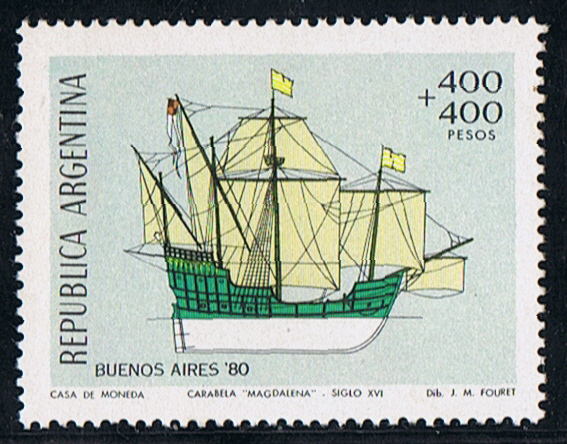 Not much is know about the caravel, where and when built unknown. Tonnage 200 ton, dim. 85 x 25 x 14ft. (draught) Four masts, fore and main mast square rigged, mizzen and Bonaventura mast lateen rigged. She was the flagship of Don Pedro de Mendoza (1487-1537) expedition to the River Plata. Mendoza held a post in the court of Charles V, when he in 1534 made an offer to Emperor Charles V to make an expedition on his own account for the discovery and conquest of Paraguay and the countries on the Rio La Plata. 24 August 1534 Mendoza on board the MAGDALENA and 13 other vessels, with 3000 men set sail from San Lucar, Spain. Receive from the Emperor before sailing 2.000 ducats, with the condition, when he transported to the new founded colonies 1000 colonists and 100 horses, build a road to the Pacific Ocean, erect three forts within two years he would receive 2.000 ducats more. Also he had to take 8 monks, a physician, a surgeon, and an apothecary, but he was forbidden to introduce a lawyer in the colony. He was to have half the treasure of the chiefs killed and nine-tenths of the ransom. Mendoza was made before sailing military governor of all the territory between the Rio de la Plata and the Strait of Magellan. The office of the Governor was also made hereditary. Off the coast of Brazil the fleet was scattered in a heavy storm, and Medoza lieutenant Osario, was assassinated, according to some authorities by the orders of Mendoza himself because of suspected disloyalty. 1535 Mendoza sailed up the Rio de la Plata, and founded Buenos Aires on 02 February 1536. He erected two forts there to defend the place. Pestilence broke out and the natives became unfriendly after ill treatment by the Spaniards. His brother Don Diego led a force against the hostile tribes, but was killed with three-fourths of his men. A general conspiracy of the natives was formed, and Buenos Aires was captured and burned by the natives. Mendoza retired to the forth Sanctus-Spiritus, from where he dispatched Juan de Ayolas to explore the upper part of the river. Another brother, Gonzalo arrived with reinforcements and founded the city of Ascención in Paraguay in 1536. Mendoza, disappointed and with a broken health, embarked on board the MAGDALENA for Spain in 1537, leaving Juan de Ayolas in charge. During the long voyage to Spain he died maniac on board the MAGDALENA on 23 June 1537. The fate of the MAGDALENA is not known. Argentine 1979 400p + 400p sg 1646 Source: mostly copied from http://en.wikipedia.org/wiki/Pedro_de_Mendoza http://famousamericans.net/pedrodemendoza
https://shipstamps.co.uk/forum/viewtopic.php?t=6731
|
|
|
|
|
Dimensions of the Cheops-pyramid (Khufu's pyramid)
Numbers and figures of the Cheops (Khufu) pyramid:
The pyramid of Khufu - Output / performance - Building material - Dimensions of the pyramid - Dimensions in Royal Cubits - Sources
 Cheops-pyramid (pyramid of Khufu) Cheops-pyramid (pyramid of Khufu)
Of the the famous Seven Wonders of the Ancient World the Great Pyramid of Khufu (Cheops) at Giza is the only one still standing. Even for modern men it is amazing how this man-made structure lasted so long.
The Giza pyramids must have made an incredible visual impact - at the edge of the desert three abstract geometrical symbols were rising, huge luminous white triangles reflecting the blinding light of the sun!
The pyramids on the Giza plateau are with 146.59m (Khufu / Cheops) and 143.87m (Khafre / Chefren) respectively the largest, however there are over 30 major pyramids and a myriad of smaller pyramids in Egypt.
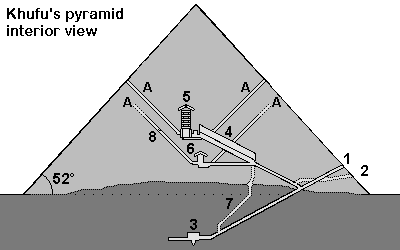
Cheops-Pyramid
1. Entrance 2. Entrance cut by grave robbers 3. Subterranean chamber 4. Grand Gallery 5. King's chamber, relieving chambers, granite portcullis slabs 6. Queen's chamber 7. Shaft 8. Limestone plugging the air shaft A= "Air shafts"
 Output / performance Output / performance
 Detailed calculations how many workers were necessary to build the pyramid Detailed calculations how many workers were necessary to build the pyramid
 Overview pyramid building Overview pyramid building
Builder
------------------- |
|
Khufu (Chuefui-Chnum or Khnum-Khuf, Cheops in Greek) during the 4th dynasty of the old kingdom |
| Time to build |
|
Probably max. 23 years (Khufu reigned from 2551 to 2528 before Christ *). Herodotus writes about 10 years of preparation and 20 years of building (details of the text) |
| Per day |
|
With 2'500'000 stones 342 stones have to be moved daily (working during 365 days a year) or 431 stones daily (working during 290 days a year). |
|
Per minute
|
|
10-hour day: every 2 minutes a stone (34 to 43 per hour)
8-hour day: nearly a stone every minute (42 to 53 stones per hour)
|
| Rule of thumb |
|
| While construction the pyramid the rate of delivery was 1 stone weighting 2.5 tons every minute. |
For our calculations we assume 500 stones a day. This is a rough estimate, assuming a 8-hour day, during 290 days a year, with 20 years to build the pyramid. Also assuming, that more time had to be used for the huge granite blocks for the King's chamber and for the more difficult upper part of the pyramid, where work went slower than in the lower parts. There probably were also other factors delaying the building of the pyramid such as the weather or a temporary shortage of certain building materials.
|
 Building materials for the Cheops-pyramid Building materials for the Cheops-pyramid
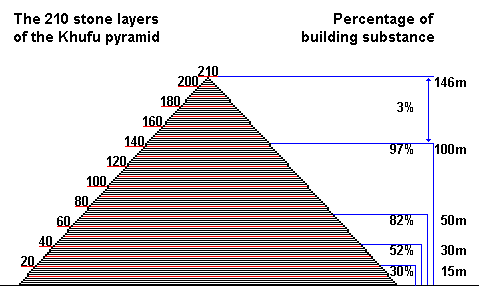
The Khufu-pyramid (Cheops) probably originally had 210 stone layers. At 50m height already 82% of the entire pyramid was built [3].
 Quarrying stones for the pyramid Quarrying stones for the pyramid
 Shipping the stone blocks down the Nile to Giza Shipping the stone blocks down the Nile to Giza
 Transporting the stone blocks using a sledge on tracks Transporting the stone blocks using a sledge on tracks
 Löhner's rope roll Löhner's rope roll
Stone blocks
------------------- |
|
2'300'000 stones |
| Casing blocks |
|
115'000 to 200'000 stones or 67'390m³ [1] |
| Total blocks |
|
2'500'000 stones |
| Stone layers |
|
Originally probably 210 stone layers, now only 201 layers [2] |
| Stone size |
|
The stone blocks usually are larger in the lower layers (1.5m = 3 cubit) and smaller in the upper layers. Most are between 1.5 and 2 cubit large (average of 127 x 127 x 71cm). 1 cubit = 0.524m - Details |
| Weight of the stone blocks |
|
With an average density of 2,6 - 2,9 t/m³ the large limestone blocks weighted 6.5 - 10 tons and the smaller ones about 1.3 tons. For all calculations on this website an average weight of 2.5 tons was used. |
| Special blocks |
|
For the King's chamber granite blocks weighting 40 to 50 tons were used |
| Total weight |
|
6'500'000 tons (average weight of a block was about 2.5 tons) |
| Pyramidion |
|
The final stone on the top was a large block in the shape of a pyramid. It was perhaps around 1.5m by 1.5m wide and 1.3m high (about 3 cubits). It was made from white Tura limestone (Turah), granite or perhaps diorite and perhaps gold plated. More information |
| Building materials |
|
Pyramid: Nummulite limestone from quarries about 200-400m south of the pyramid were used for the core stones.
Casing: light white limestone, so called Tura-limestone from quarries from the eastern shores of the Nile
King's chamber: Rose granite from Aswan 900km away
Further materials: Graywacke from the Wadi Hammamat (Eastern desert), basalt from the northern Faiyum
 Map of quarries in Egypt Map of quarries in Egypt
|
 Dimensions of the pyramid of Khufu Dimensions of the pyramid of Khufu
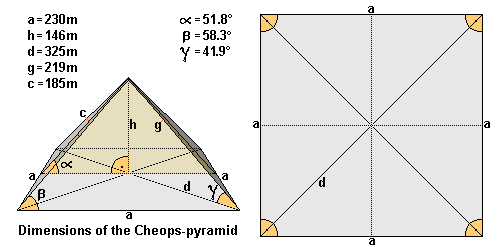
Length (a)
------------------- |
|
The average length of the edge is ~ 230.360m (230,12m = 440 cubits). Northern edge 230.328m - eastern edge 230.369m - southern edge 230.372m - western edge 230.372m. Largest difference is only 4.4cm. [3] |
| Height (h) |
|
Originally 146.59m high (= 280 cubits), the pyramid is now only 138.75m high [7] |
| Diagonal (d) |
|
325.77m |
| Ridge (g) |
|
219m |
| Height of the lateral surface |
|
186.42m |
| Pyramid angle α |
|
51° 50' 40' = inclination of the lateral surface (= 52° rounded off) [3] which corresponds to a seked of 5½ palms |
| Pyramid angle β |
|
58.3° = the two angles of the triangular lateral surface (62° = angle of the apex or tip of the pyramid) - nearly forming an equilateral triangle! |
| Pyramid angle γ |
|
41.9° = angle of the ridge |
| Corner angle |
|
Right angle base with angles from 89° 59' to 90° |
| Base area |
|
53'065.73m² |
| Superficies surface |
|
85'890.69m² |
| Pyramid volume |
|
2'592'968.43m³ including the rock core. This would be a cube with a length of 137.38m. Probable volume of stones used: 2'583'283m³ [1] or 2'326'501m³ [2]. |
| Alignment |
|
Exactly to the north (deviation only 2' 28') |
| Latitude and longitude |
|
N 29° 58’ 44.3830” latitude and E 31° 07’ 57.0194” longitude [5] |
| Altitude |
|
The base of the pyramid of Khufu lies about 60m above sea level, so the tip of the pyramid used to be on 206m above sea level [6]. |
 Alignment of the pyramids and controlling the shape of the pyramid (north-south alignment etc.) Alignment of the pyramids and controlling the shape of the pyramid (north-south alignment etc.)
 Dimensions of the pyramid of Khufu in Egyptian Royal Cubits Dimensions of the pyramid of Khufu in Egyptian Royal Cubits
 |
Length (a) |
|
440 Royal Cubits |
| Height (h) |
|
280 Royal Cubits |
| Height of the lateral surface (c) |
|
356 Royal Cubits (356.09) |
| Diagonal (d) |
|
622.25 Royal Cubits |
| Ridge (g) |
|
418.56 Royal Cubits |
| Pyramid angle α |
|
51.843° |
| Pyramid angle β |
|
58.3° |
| Pyramid angle γ |
|
41.9° |
| Corner angle |
|
90° |
It is suggested, that the Egyptians used a right angled triangle to determinate the angle of inclination of the pyramid, using the numbers a=11 and b=14 with c=17.8 (or a=22 - b=28 - c= 35.6). This determines a so called seked of 5½ palms.
 Alignment of the pyramids and controlling the shape of the pyramid (seked) Alignment of the pyramids and controlling the shape of the pyramid (seked)
 Sources Sources
[1] M. Lehner The Complete Pyramids of Egypt
[2] G. Goyon Die Cheops-Pyramide
[3] R. Stadelmann Die grossen Pyramiden von Giza
[4] F. Abitz Der Bau der grossen Pyramide mit einem Schrägaufzug
[5] GPS-coordinates of a brass disk on top of the pyramid of Khufu, Giza Plateau Mapping Project (GPMP)
[6] Maps of the Giza Plateau Mapping Project show the altitude as 60m
[7] D. Arnold Building in Egypt
* Dates according to conventional Egyptian chronology are used in this website. These are based on several list of the dynasties of pharaohs, for example the Aegyptiaca of Manetho of Sebennytos.
https://www.cheops-pyramide.ch/khufu-pyramid/khufu-numbers.html |
|
|
|
|
47.6208°N 3.0482°W[41] A large dolmen measuring 12 by 5 m (39 by 16 ft), with a 5 m (16 ft) long broken capstone.[6] It is named after the nearby Chapelle de La Madeleine, which is still used.
 Dolmen of Kercado. Though smaller than St. Michel, older by many centuries before 4800 BC. Dolmen of Kercado. Though smaller than St. Michel, older by many centuries before 4800 BC.
A rare dolmen still covered by its original cairn. South of the Kermario alignments, it is 25 to 30 metres (82–98 ft) wide, 5 m (16 ft) high, and has a small menhir on top. Previously surrounded by a circle of small menhirs 4 m (13 ft) out,[39] the main passage is 6.5 m (21 ft) long and leads to a large chamber where numerous artifacts were found, including axes, arrowheads, some animal and human teeth, some pearls and sherds, and 26 beads of a unique bluish Nephrite gem. It has some Megalithic art carved on its inner surfaces in the form of serpentines and a human-sized double-axe symbol carved in the underside of its main roof slab. In ancient cultures, the axe and more precisely the bi-pennis used to represent the lightning powers of divinity. It was constructed around 4600 BC and used for approximately 3,000 years.[39]
A roughly rectangular mound, with only one capstone remaining. It is aligned east-to-west, with a passage entrance to the south.[42]
On a small hill, has two separate chambers.
(Pixies' mound or Grotte de Grionnec[39]):A group of three dolmens with layout unique in Brittany,[39] once covered by a tumulus. Whereas most groups of dolmens are parallel, these are arranged in a horseshoe. The largest of the three is at the east, 11 metres (36 ft).[38]
 The Crucuno dolmen The Crucuno dolmen
A "classic" dolmen, with a 40-tonne (44-short-ton), 7.6-metre (24 ft 11 in) tablestone resting on pillars roughly 1.8 m (5 ft 11 in) high. Prior to 1900, it was connected by a passage making it 24 m (79 ft) long.[39]
Crucuno stone rectangle
[edit]
47.625°N 3.122°W: A classic 3, 4, 5 rectangle of 21 menhirs varying in height from 0.91 metres (3.0 ft) to 2.4 metres (7.9 ft) that is aligned along its diagonal to the midsummer sunrise. Alexander Thom suggested it measured forty by thirty of his megalithic yards.[43]
 The Manio quadrilateral arrangement The Manio quadrilateral arrangement The Manio "Giant" The Manio "Giant"
There are some individual menhirs and at least one other formation which do not fit into the above categories.
Manio quadrilateral
[edit]
An arrangement of stones to form the perimeter of a large rectangle. Originally a "tertre tumulus" with a central mound, it is 37 m (121 ft) long, and aligned to east of northeast. The quadrilateral is 10 m (33 ft) wide to the east, but only 7 m (23 ft) wide at the west.[44]
47.603°N 3.056°W[45] Near the quadrilateral is a single massive menhir, now known as the "Giant". Over 6.5 m (21 ft) tall, it was re-erected around 1900 by Zacharie Le Rouzic,[39] and overlooks the nearby Kerlescan alignment.[46]
Excavation and analysis
[edit]
 Large upright in the Ménec alignment Large upright in the Ménec alignment
From the 1720s increasing interest was shown in these features.[47] In 1796, for example, La Tour d'Auvergne attributed them to druidic gatherings.[39] In 1805, A. Maudet de Penhoët claimed they represented stars in the sky.[39]
Englishmen Francis Ronalds and Alexander Blair made a detailed survey of the stones in 1834.[48] Ronalds created the first accurate drawings of many of them with his patented perspective tracing instrument, which were printed in a book Sketches at Carnac (Brittany) in 1834.[49]
Miln and Le Rouzic
[edit]
The first extensive excavation was performed in the 1860s by Scottish antiquary James Miln (1819–1881), who reported that by then fewer than 700 of the 3,000 stones were still standing.[50] Towards 1875, Miln engaged a local boy, Zacharie Le Rouzic [fr] (1864–1939), as his assistant, and Zacharie learnt archaeology on the job. After Miln's death, he left the results of his excavations to the town of Carnac, and the James Miln Museum was established there by his brother Robert to house the artifacts. Zacharie became the director of the Museum and, although self-taught, became an internationally recognised expert on megaliths in the region. He too left the results of his work to the town, and the museum is now named Le Musée de Préhistoire James Miln – Zacharie le Rouzic.[51][52]
 The Ménec alignments of some 1,100 stones in 11 columns The Ménec alignments of some 1,100 stones in 11 columns
In 1887, H. de Cleuziou argued for a connection between the rows of stones and the directions of sunsets at the solstices.[39]
Among more recent studies, Alexander Thom worked with his son Archie from 1970 to 1974 to carry out a detailed survey of the Carnac alignments, and produced a series of papers on the astronomical alignments of the stones as well as statistical analysis supporting his concept of the megalithic yard.[51][53] Thom's megalithic yard has been challenged.[54][55]
There are also general theories on the use of the stones as astronomical observatories, as has been claimed for Stonehenge. According to one such theory, the massive menhir at nearby Locmariaquer was linked to the alignments for such a purpose.[15]
 Sheep grazing around the Kerlescan alignment, part of a new management strategy Sheep grazing around the Kerlescan alignment, part of a new management strategy
The Musée de Préhistoire James Miln – Zacharie le Rouzic is at the centre of conserving and displaying the artefacts from the area.[52] It also contains the "world's largest collection [of] prehistoric[al] exhibits"[38] with over 6,600 prehistoric objects from 136 different sites.
The monuments themselves were listed and purchased by the State at the start of the 20th century to protect them against quarrymen, and while this was successful at the time, in the middle of the century, redevelopment, changes to agricultural practices and increasing tourism bringing visitors to the stones led to rapid deterioration. The Ministère de la Culture et de la Communication (Heritage Ministry) re-examined the issue starting in 1984, and subsequently set up the 'Mission Carnac' in 1991 with the aim of rehabilitating and developing the alignments. This involved restricting public access, launching a series of scientific and technical studies, and producing a plan for conservation and development in the area.[56]
As with the megalithic structure of Stonehenge in England, management of the stones can be controversial. Since 1991, the main groups of stone rows have been protected from the public by fences "to help vegetation growth",[38] preventing visits except by organised tours. They are open during winter, however.[57] When James Miln studied the stones in the 1860s, he reported that fewer than 700 of the 3,000 stones were still standing, and subsequent work during the 1930s and 1980s (using bulldozers) rearranged the stones, re-erecting some, to make way for roads or other structures. In 2002, protesters invaded the site, opening the padlocks and allowing tourists free entry.[50] In particular, the group Collectif Holl a gevred (French and Breton for "the everyone-together collective") occupied the visitor centre for the Kermario alignment, demanding an immediate stop to current management plans and local input into further plans.[58]
In recent years, management of the site has also experimented with allowing sheep to graze among the stones, in order to keep gorse and other weeds under control.[59]
In June 2023, 39 menhirs still outside the UNESCO protected site were destroyed to construct a DIY store of the Mr. Bricolage franchise, which obtained a building permit from the local town hall in August 2022. The affected stones are located in the town of Montaubin, separate from the primary tourist locations of Ménec and Kermario, which are situated a little over 1.5km (1 mile) away. The town's mayor, Olivier Lepick, told AFP that he had "followed the law" and pointed to the "low archaeological value" of objects found during checks before the construction process began. He also admitted to being unaware that the site was listed on the Heritage Atlas, despite reportedly presiding over the group that applied for UNESCO status for the prehistoric sites. While Lepick blamed the region's complex zoning situation, the researcher Christian Obeltz claimed that "elected officials in the area and the department are in a hurry to build up anything because once it is classified with UNESCO, it won't be possible anymore". The local Koun Breizh association has decided to lodge a complaint with the public prosecutor of Vannes for willful destruction of sites that relate to archaeological heritage.[60][61][62][63]
https://en.wikipedia.org/wiki/Carnac_stones |
|
|
|
|
Carnac can refer to different things. Mostly the town located in Brittany, France. Famous for its neolithic & megalithic monuments

Carnac stones (Breton: Steudadoù Karnag)
In the NW of France. Carnacs monuments date back to prehistoric times and are a popular tourist attraction. They provide insight into the ancient history, the neolithic age, and the culture of the region.
These monuments are among the most famous and extensive megalithic sites in the world, and are estimated to date back to the neolithic period.
More than 3,000 prehistoric standing stones were erected by the pre-Celtic people of Brittany
They form the largest such collection in the world. (1)
From local granite, ancient ancestors, erected them
Probably around 3300 BC but some may be as early as 4500BC. (2)
Different people have different stories
Some associate the stones with 1st century AD romans, and later Christian occupations. Including that soldiers were turned to stone in pursuit of the pope. (3)(4)(5)
More commonly, local tradition claims. A legion was turned to stone by the popular wizard Merlin
From King Arthur legend.
The questions of the carnac stones are still being debated.
Currently at, and around the main site. The 3 major groups of stone rows are: Ménec, Kermario and Kerlescan
 
Ménec alignments have eleven rows of menhirs. 1,165 by 100 metres; or 3,822 by 328 feet
Some considered stone circles made at either end. Especially in the west. The largest stones are 13 feet or 4 meters. It lowers a bit in the middle and rises again in the extreme eastern end.
 
Kermario alignment is 10 columns. Spread about 1300 meters or 4300 feet long
More of a fan like layout. 1029 stones are found in 10 columns. It is also believed a stone circle was here. In the east. Revealed by satellite photography. (6)

Kerlescan alignments is 13 lines. With total length around 800 meters (or, 2600 ft)
A smaller group of 555 stones. Exists further to the east of the other two sites. The stones here also vary in size from about 80cm (or 2 foot 7 inches) to 4 meters, or 13 feet. (7)
Petit-Ménec alignments are much smaller and covered in the woods (8)
There are also three known tumuli
They are: Carnacéen, Saint-Michel, Tumiac and Mané-er-Hroëk (9)
From the Carnac and Morbihan area. Carnacéen maybe around 7000 years old Containing a burial chamber, and one individual. Callaïs jewelry, stone arm rings and polished stone axe heads from the Italian alps were found too.
Because jade is a hard stone. The axe heads 46 cm in length. Would have taken over one thousand hours to produce.

Saint-Michel is a tumulus constructed between around 7000 and 5400 years ago
At its base it is 125 metres or 410 ft long; 50 metres (160 ft) wide; and, 10 metres or 33 ft high. (10). To produce. It required 35,000 cubic metres (46,000 cu yd) of stones and earth.
With its known neolithic and prehistoric significance. A chapel was built on top of the Tumulus in 1663
The current building is an identical reconstruction of the 1663 chapel, built in 1926.
Tumiac is known as Caesars mound because of its location as a observation tower during the Veneti war
South of the Gulf of Morbihan. In 1853 archaeologists excavated a site, and carbon 14 dated it to 4790 or 4530 BC. The tumulus, elliptical and circular in shape. Is made of layers of clay. It is 50 meters wide; and, 15 meters in height. It contains several rectangular burial chambers. With monolithic supports and quartz slabs. It also had jadeite axes. Firbolite azes and callaïs beads.

Mané-er-Hroëk is a rectangular burial vault of about 5m by 3m. Covered with two slabs. On a 100x60mx8m mound
Many stone axes, and jewelry including callaïs were found here. Its modern entrance is an addition.
There are dolmens in the area too
They are: Er-Roc’h-Feutet, La madeleine, Kercado, Mané Brizil, Kerlescan, Mané-Kerioned, Crucuno and Crucuno stone rectangle

Er-Roc’h-Feutet
An enormous cover stone covers the chamber, and the passageway still has its capstones. Near La Madeleine.
La Madeleine is 12x5m with a broken capstone
Kercado is almost 100 feet wide. It was previously surrounded by stone circle
Down its 21 foot main passageway. Neophite gems, beads, human and animal teeth and numerous artifacts were found. Believed to be constructed around 4600 BC.

Mané Brizil
Kerlescan
A roughly rectangular mound, with a capstone remaining, and entry from the south.
Kermarquer
On a small hill, has two separate chambers.
Mané-Kerioned is a unique group of 3 dolmens. Once covered by a tumulus
Crucuno is a classic dolmen. 1.8 meter pillars supporting a 40 ton tablestone
Crucuno stone rectangle has 21 menhirs. From about 3 to 8 feet height
Other menhirs, and formations that do not fit into categories
There’s also the manio quadrilateral, and manio giant
Manio quadrilateral, Is 121 feet long and 23-33 feet wide
Believed to have a central mound. Or, originally be a “tertre tumulus”.
Manio giant is near the quadrilateral. A single massive menhir
Over 6.5 m or 21 feet tall. It overlooks the Kerlescan alignment.
In 1796, La Tour d’Auvergne attributed the stones to druidic gatherings.
Others said they were stars or planetary formations. And, some that they were used for workouts, and team building exercises.
Did you know? In 1834 Englishmen Francis Ronalds and Alexander Blair drew them. In Sketches at Carnac (Brittany). A popular book for the time.
In the 1860s, extensive excavation was performed
It was James Miln (1819–1881), a Scottish archaeologist and historian. He reported that fewer than 700 of the 3,000 stones were still standing, and that the sites should be further investigated. Eventually he engaged Zacharie Le Rouzic (1864–1939), a local boy, as his assistant.
The Musée de Préhistoire is now named in boths honour
Displaying the ‘largest collection of prehistoric exhibits’. Will over 6600 displays, from 136 sites.
The exact purpose and cultural significance of Carnacs megalithic monuments remain topics of scholarly study and debate. They’re a testament to the skills and beliefs of the prehistoric people who constructed them. It continues to attract tourists, and historians from around the world. Interested in understanding our historical and cultural significance.
https://neolithicarch.com/carnac/
|
|
|
|
|
Le site de la chapelle était autrefois une léproserie. La chapelle actuelle a été reconstruite en 1976. Une permanence est assurée l'été par les habitants du quartier. Le pardon a lieu en juillet. A côté de la chapelle, vous découvrirez sa fontaine, dont la source est recherchée pour guérir la fièvre et les maladies de peaux.
A proximité le dolmen er-Roch-Feutet
https://www.cirkwi.com/fr/point-interet/489615-chapelle-de-la-madeleine |
|
|
 Primeira Primeira
 Anterior
13 a 27 de 27
Seguinte Anterior
13 a 27 de 27
Seguinte
 Última
Última

|



